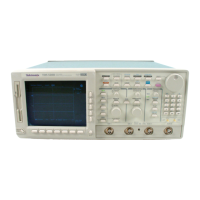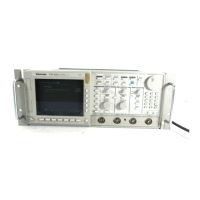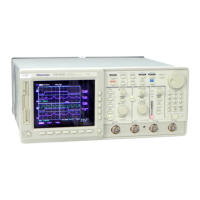Saving and Recalling Waveforms
TDS 340A, TDS 360 & TDS 380 User Manual
3–47
The reference waveforms maintain their contents indefinitely, regardless of the
power state or setup of the instrument. To remove a selected reference waveform
from the display, press WAVEFORM OFF.
To recall a reference waveform simply press its front panel button (REF 1 or
REF 2).
Using the Disk
You can save waveforms to a floppy disk in several useful formats for mass
storage or transfer to other applications. You can recall waveforms for display as
reference waveforms.
To select the file format that the oscilloscope uses to save waveforms to a file,
press the front-panel button SAVE/RECALL, and then the main-menu button
Save Format. Three format choices are available using the side-menu buttons:
H Internal creates files (.ISF) in the internal format of the oscilloscope
H MathCad creates files (.DAT) in a format usable by MathCad
DAT files are supported by the MathCad numerical analysis program. DAT
file data is read line by line and placed into variables in the MathCad
document. You then do whatever calculations are required. The DAT format
begins with four values acting as a header containing the record length, time
per sample interval, trigger location, and trigger offset, followed by a linear
array of ASCII floating-point Y values. The recordLength, pre–trigger
sample count and trigger offset are in samples. The horizontal scale per
sample is in x units and the y value is in y units.
H Spreadsheet creates files (.CSV) in a format usable by most spreadsheets
(Excel
, Lotus 1-2-3
, and Quattro Pro
)
CSV files (Comma Separated Values) contain comma separated X and Y
ASCII values on CRLF terminated lines (a 2 dimensional array). Each value
is a floating point number. There is one line for each point in a waveform
record. The X and Y values are displayed in the units of seconds and Volts.
All scaling to sample increments and offsetting has been done. Zero on the X
scale is the trigger point, with negative values being pretrigger and positive
values being posttrigger.
Refer to Viewing a Waveform on a Spreadsheet on page 3–49 for an example
of using this format.
Recalling a Reference
Waveform
Selecting the Save Format

